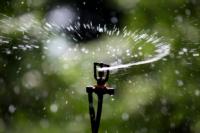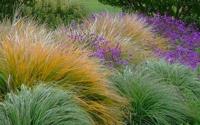Water-wise Gardening
Water is essential for all plant growth. In fact, about 90% of a plant is made up of water. However, both over and under watering can cause plant stress or event death. The goal of irrigation is to provide the correct amount of water at the right time to optimize water uptake by the roots.
While water is necessary for plant survival, plants differ in the amount of water they require. Proper plant selection and efficient irrigation methods can drastically reduce landscape water usage. Since about 30-60% of water usage in a single family home is for landscaping and garden, maximizing water use efficiency should be a primary consideration in all landscape design.
10 Tips for a Water-wise Landscape
1) Limit your Lawn
A lawn is usually the single largest water user in the home landscape. Many large expanses of turf are underutilized but still require considerable resources, time and effort to maintain. Use turf only when it serves a purpose, such as play or entertainment areas. Consider replacing unused turf areas with hardscapes or native plants, adding interest and color to your yard while decreasing water use.
Ornamental Grasses as Lawn Alternatives
If you do decide to have a limited lawn area, consider the following water saving tips:
- Select water efficient varieties suited for the Plumas and Sierra climate. Cool-season varieties with low water requirements include:
- Hard fescue
- Chewing's fescue
- Red fescue
- St. Augustine grass
- Tall fescue - relatively drought tolerant despite having high water requirements.
- Adjust irrigation schedules monthly to reflect seasonal changes.
- Water early in the morning - ideally from 3 a.m. - 8 a.m.
- Mow lawns at 2-3" height to reduce growth rate, promote deeper root growth and shade soil
- During times of drought, cut irrigation duration to half the amount recommended in the UC Lawn Watering Guide
2) Plant Water-wise
- Select plants with low-water requirements and those that are appropriate to our Mediterranean climate. See the WUCOLS database for a list of plants appropriate for our region (Hint: our area is included under Central Valley)
- Plant native plants. Native plants generally have lower water requirements than other plants. Check out CalFlora for a list of plants native to our region.
3) Prioritize your Plants
When water is limited, most people choose to water fruit trees, ornamental trees and shrubs. Lawns, groundcovers and bedding plants can be re-established in a relatively short time, but trees and shrubs need years to mature and are less easily replaced.
4) Irrigate Smartly
Efficient irrigation methods can help keep plants healthy during dry periods while also limiting water use.
- Install a drip system. Drip irrigation systems are over 90% efficient while hand watering and sprinklers range from 50-70% efficiency.
- Replace sprinkler heads with low-flow options. Irrigating slowing allows water to infiltrate the soil more completely, wetting the complete root zone and avoiding runoff.
- Avoid sprinkler overspray. Make sure sprinklers are not watering driveways, sidewalks or areas that do not require irrigation
- Avoid runoff and puddling. Use pulse irrigation (5 min on, 5 min off, 5 min on) to encourage better infiltration if runoff is an issue.
- Group plants according to water needs
- Think before you water. Check soil moisture at 6-8" depth before irrigating.
5) Don't Over Fertilize
Increased plant growth means increases in water demand
- Select low Nitrogen fertilizers if you do chose to fertilize
6) Know your Soil Type
The type of soil you have determines how frequently you should water.
- Clay soils need to be watered less frequently
- Sandy soils need to be watered more often but for shorter periods of time as water percolates past the root zone quickly
7) Add Organic Matter (Compost) to your Soil
Organic matter increases the ability of your soil to hold onto water.
8) Mulch, Mulch, MULCH!
Get the point? A 3-4 inch layer will reduce water evaporation, protect roots from heat and reduce competitive weeds. A good mulch layer can reduce irrigation need by about 50%.
9) Control Weeds
Weeds around vegetables, trees and shrubs can out compete garden plants for water and nutrients.
10) Recycle Water
An often overlooked water management option is recycled water. Recycled water, or greywater helps conserve water and electricity and reduces water bills. An estimated 30 – 50 percent of water consumption results in gray water that can be recycled into the landscape. Most homes can supply one-half to three-quarters of their water-efficient landscape needs using gray water.
Recycled greywater sources:
- Residential washing machines
- Bathtubs
- Showers
- Sinks
NOT greywater sources:
- Kitchen sink
- Dishwasher
- Toilets
Greywater is not approved or recommended for use on edible plants. Use greywater on non-edible, ornamental landscapes. Greywater regulations are evolving; check with the California Department of Housing and Community Development (HCD) Division of Codes and Standards website and local agencies before planning or installing a greywater system.

Helpful Links
Drought Tips for Home Gardeners - Tips for helping your landscape survive the drought
Water-wise Landscape Design
Landscape Design & Water Quality
Easy Water-wise Gardening - Advise and design from Sunset Magazine
Water Efficient Landscapes - California Department of Water Resources
Principles of Xeriscape Design
Irrigation
Drip Irrigation - Intermediate

What is a Xeriscape?
A xeriscape is a landscape that emphasizes water conservation
10 Principles of Xeriscapes
1) Group plants according to their requirements for sun and water
2) Zone irrigation systems to match plant requirements
3) Adjust irrigation frequency and/or duration at least 4 times per year
4) Design irrigation systems to emphasize uniformity
5) Use turf for function more than appearance
6) Use islands of intensely managed irrigated plantings for accent
7) Select plants that are well adapted to your climate
8) Include hardscape design elements, such as patio and decks in the landscape design
9) A good xeriscape is economical reflecting monthly water bill savings
10) A good xeriscape combines function and beauty

